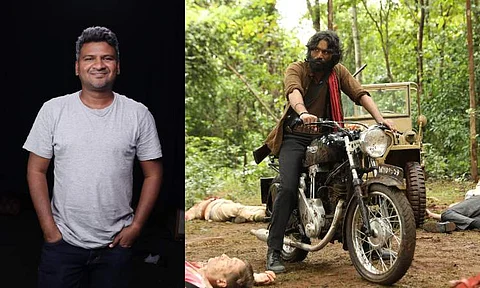

A quaint little village in the imposing shadows of the British empire… Dhanush with a man-bun and half-dazed eyes that glint with rage and indifference… A group of biker bandits racing in the rustic, weather-beaten landscape of southern Tamil Nadu… Captain Miller brims with such visual potential. However, it must be said that easy access to rock makes not the job easier for a sculptor. Cinematographer Siddhartha Nuni shares that director Arun Matheswaran and he were united by their love for the legendary Japanese filmmaker, Akira Kurosawa. “We bonded over his cinema,” Siddhartha says. “Captain Miller bears similarities to Kurosawa’s celebrated films like Seven Samurai. A village is in trouble, and people come together to protect it from larger forces. Even from the initial discussions, it was clear to me how I would approach this visually.”
The DOP begins discussing the specifics. “Take the scene in Captain Miller where Dhanush stands in front of the temple, waiting for the British army to charge, even while the dust is billowing. That’s us paying homage to a beautiful shot at the end of Yojimbo as Toshiro Mifune walks back into the village with a katana in hand.” The dust in the scene isn’t accidental; across the film, natural elements get used to accentuate mood and emotion. Dhanush’s Analeesan, during a moment of profound transformation, stands silhouetted against a raging fire. Viji Chandrasekhar's Pechiamma, in her opening monologue, is surrounded by smoke from a wood stove, and Captain Miller himself wades through a stream. “Wind, smoke, fire, and rain… we used it all—and this too is inspired by Kurosawa,” he says. It’s not all a homage to the past though. There are several modern techniques used too. “On the first day, we shot the scene that comes after the interval—the one in which the villagers get tortured by the British soldiers at night. The village is silhouetted against blue lighting in the background. For such night sequences, we referenced All Quiet on the Western Front (2022). Everything else was shot in natural light,” says Siddhartha.
As for the locations, a major portion of the film was shot in Courtallam. “This is a dream location for a cinematographer. No matter where you place the camera, the scenery looks beautiful.” However, nature remains impartial to human suffering—and posed many challenges during the shoot. “In Courtallam, by 4 pm, the sun starts setting behind the mountains, so I was quite worried about maintaining an even tone.” That is when Steven Spielberg (who has spoken about his own love for Kurosawa) stepped in to help the crew. “After extensive research about films dealing with our theme and set around the same period, we learned how Spielberg circumvented similar issues in Saving Private Ryan by using a process called bleach bypass to get a softer tone in the film. We adopted something similar.”
Apart from cinematic techniques handed down by veteran filmmakers, Siddhartha’s own favourite visual treatment—the use of black and white—also found a place in Captain Miller. On his love for monochromatic visual language, Siddhartha explains, “When you look at a black-and-white photo, the colour is all gone, leaving only the soul for you to witness.” Incidentally, the first scene of the film, which opens on an old lady narrating the mythology of a village deity, is a monologue presented to us entirely in black and white. This is also Siddhartha’s most favourite shot from the film, who demonstrates his inclination with the aid of a quote from his favourite cinematographer, Roger Deakins. “People confuse ‘pretty’ with good cinematography.”
While the opening scene in Captain Miller is not a conventionally beautiful scene, it underscores the intent of the moment and pushes the narrative forward. “Pechiamma narrating the history of the temple was a single long take that starts on her face and gradually moves outwards and as it does, we slowly start seeing the village, the people, the way of life, and the temple stands tall in the background.” He adds after a pause, “When we captured that scene, it was primarily to introduce the audience to the village. But since the scene also has Pechi talking about the history of the world, of the mythology, of the village deity who is at the heart of the story, there’s another visual layer.” He hammers home his point by concluding, “The introduction of the village is supposed to be delivered directly whereas—through the mythology—we are introduced to the world of Captain Miller subliminally. These two layers need to work in tandem. It is myth building in visual format.”
Director Arun Matheshwaran has revealed interest in making a prequel and a sequel to Captain Miller. Siddhartha explains, “I have a general idea of what Arun has in mind for a prequel—and I’ll be game to return for explosion and action.”